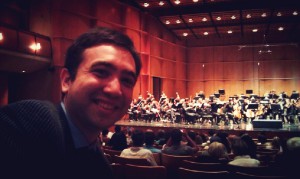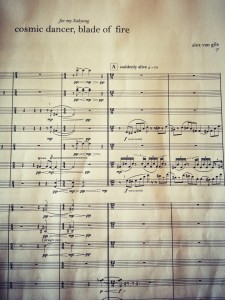Sunday
Arts and PoetryOn Composing a Symphony
by Shastri Manuel Medeiros
On a warm June evening, the University of California Davis Symphony Orchestra performed their final concert of the season at the elegant Mondavi Center for the Performing Arts on the university campus. Among the pieces performed was one written by Shambhalian Alex Van Gils. Mr. Van Gils is a member of the Davis Shambhala Center, a founding member of the Ziji Collective, a long-time member of the Dorje Kasung – and just an all-around nice guy. But most importantly, for this article, Mr. Van Gils is an exciting young composer (www.alexvangils.com), a PhD candidate in composition at UC Davis. Mr. Van Gils’s piece was selected for performance from among three finalists by the composition faculty.
Alex’s symphonic work is entitled cosmic dancer, blade of fire, a recording of which he has generously allowed to be included here. I asked Mr. Van Gils if I might interview him about the piece, his artistic process, and the relationship of the piece to Shambhala teachings. He graciously agreed.
When did this piece begin to take form for you?
I was at Warrior Assembly 2012, doing two weeks of meditation and practice with the stroke of Ashe. During one of the practice sessions I just had this kind of mental sound-image arise of the opening of the music. Around the same time, an image of faster music came up – sort of off-kilter dance music, almost a Latin-rhythm dance you might hear in the next sections. I was hearing a big dance for orchestra.
How did you come upon the title and theme for the piece?
When I was growing up, my parents had a book of Picasso artwork. The first pages were full of his light-drawings: as the camera’s shutter opened, Picasso quickly swung his flashlight through his darkened room, painting an image that could only be seen in the mind’s eye, until the film was developed. [1] That was always the image, working with the Ashe, the blade principle, and the dancer quality. Specifically, there’s the idea that, “You are space itself.” The dancer is within space, but she also is space. And that’s us! We’re moving through this experience of reality, but there’s actually no distinguishing between us and the nature of reality. It’s not a subject moving through an object; it’s just one.
That’s the quality of the dance that’s cosmic: the dancer made of space moving through space! The blade of fire is the Sakyong and Manjushri’s sword. But it’s also this image (like a Picasso light-drawing) that when a sword moves through space, it leaves a trail. This was a “visual analog” for me to the way that the melodies are interacting with the orchestral environment. Especially in the big middle section, where the horn and the cello have these big sweeping melodies: the horn is like the edge of the blade, and the warmth of the strings is like the trail. And the way the music works is this: melodies are constantly leaving little resonant notes behind, like notes that ring past the note itself. Another instrument will pick up this resonant note and carry it farther along. That’s happening throughout the whole piece. The idea is that the blade is swiftly moving, and you experience this trail of light. Just like Picasso with the flashlight in the slowly exposed photograph.
What was really important for me in the form of the piece, was that it take the listener to the experience of space and mind – from the way the melody gets more expansive, to the ending, which is static but with these oscillatory waves of sound. In the end, the musicians are instructed with a tempo marking, “You are space itself.”
Can you say more about how Shambhala teachings informed your artistic process?
Chogyam Trungpa Rinpoche said something like, “Beethoven must have sat,” meaning that artists like Beethoven must have had some way to sit down and connect with basic goodness or space before continuing. They’re not trying to come out of doing their taxes and all of sudden start writing. [2] There’s some chance to find freshness. And I think that’s pretty important for me – in terms of setting up the environment of a composition in a way that I can have that freshness. I also think there’s another element – trust in spontaneous insight. After all the years of studying harmony and composition, and after working out harmonic possibilities in almost mathematical fashion, at the point of composition I’m not really thinking about those things – just trying to trust. Can I raise windhorse and then try to be true to what comes next?
You dedicated the piece to the Sakyong. Did you give him a copy, and if so, what was his reaction?
The Sakyong does have the piece. He said, “Oh, it looks just like what I imagined.” And then he pointed out a random measure and said, “You may have made a little mistake there.” He seemed very happy.
Is there anything more you’d like to tell us about your piece?
The most important thing for me is that my Shambhala world and all the work I do in it, and my personal practice, and my service to society, and my musical world, are not separate. A symphonic piece in particular is a public statement. It’s different from a piano sonata or a string quartet. It’s something that people are going to experience en masse – both the performers and the audience. So for me, this music had to be something that is honest and rings true to my inspiration. At the same time, it is also a public statement – a proclamation of basic goodness. Something that people can experience in a big way, a public way, without ever going to a Shambhala Center or reading a Shambhala book. It’s really important for me, in terms of how I actually reach the world and help create enlightened society. One of those elements is composing for the symphony, and I hope this is the first work of many.
[1] See “Life Behind the Picture: Picasso ‘Draws” with Light”
[2] See Chogyam Trungpa, True Perception: The Path of Dharma Art 20 (Shambhala Publications 2008).







Jun 30, 2013
Reply
Thank you for this wonderful story. Alex strikingly beautiful music!
Jun 30, 2013
Reply
Keep on proclaiming :)
Looking forward to hearing it. Thanks Alex